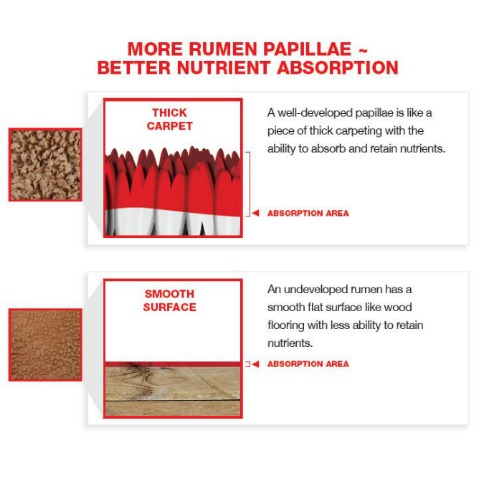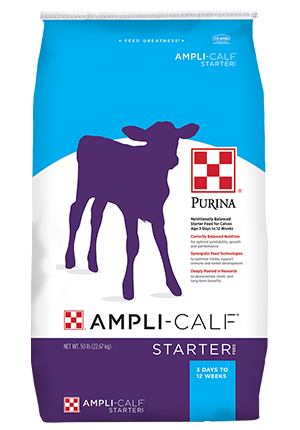
Rumen Development in Dairy Calves 101
Calf : Calf Nutrition
Heifer : Heifer Nutrition
The first 12 weeks of life is a critical period for rumen development in the dairy calf. Early forage introduction allows their small, non‑functioning rumen to grow into the healthy, functional site of nutrient breakdown and absorption as a productive cow.
What you feed your calves directly impacts rumen development, and the first 12 weeks of life is a critical growth stage when calves need adequate nutrition to support rumen development. Identifying the right grain and hay balance for your calf nutrition program will help ensure they live up to their genetic potential.Milk-only diets limit nutrient absorption
Calves fed a milk-only diet have more limited rumen development.1 Nutrients bypass the rumen and go directly into the abomasum via the reflexive closure of the reticular groove. This means the abomasum increases in size and the rumen remains small with restricted development of the rumen wall and papillae.
Papillae are the finger-like projections that line the inside of the rumen. Essential for rumen function, they increase the surface area for greater potential to absorb nutrients like a champ.
A study by Heinrichs and Lesmeister shows calves fed a high-quality alfalfa hay diet, in addition to milk or milk replacer over a 12-week period had high growth rates, but minimal papillae development compared to calves fed only milk. If calves are eating 9 or 10 lbs of starter/day before 12 weeks, start offering a small amount of hay. Until that point there is no need to offer hay.
Provide a handful of grain at three days of age and gradual increase amounts until calves are eating 3 pounds per day for 3 days in a row at weaning. It’s critical to provide adequate water along with grain to create the correct rumen environment. This will support fermentation and VFA production, which in turn stimulates rumen development. Look for a starter that is connected to the milk replacer by a special blend of ingredients. This consistency in smell and flavors helps the calves stay on feed, minimizing weaning slumps.
Using a complete calf feeding program like the Purina® AMPLI-CALF® Program is critical to provide the nutrients needed for calves to reach their genetic potential. See for yourself how a program like this could work on your farm.
1 Orskov et al., 1970
What you feed your calves directly impacts rumen development, and the first 12 weeks of life is a critical growth stage when calves need adequate nutrition to support rumen development. Identifying the right grain and hay balance for your calf nutrition program will help ensure they live up to their genetic potential.
Milk-only diets limit nutrient absorption
Calves fed a milk-only diet have more limited rumen development.1 Nutrients bypass the rumen and go directly into the abomasum via the reflexive closure of the reticular groove. This means the abomasum increases in size and the rumen remains small with restricted development of the rumen wall and papillae.Papillae are the finger-like projections that line the inside of the rumen. Essential for rumen function, they increase the surface area for greater potential to absorb nutrients like a champ.
Wait to introduce forages
Calves fed hay or forages prior to weaning will begin to ruminate, have greater flow of saliva into the rumen2 and greater muscle development of the rumen wall.3 However, this doesn’t provide sufficient concentrations of volatile fatty acids (VFAs) – especially butyrate – to promote rumen papillae growth, which is a key component to a functioning rumen.4A study by Heinrichs and Lesmeister shows calves fed a high-quality alfalfa hay diet, in addition to milk or milk replacer over a 12-week period had high growth rates, but minimal papillae development compared to calves fed only milk. If calves are eating 9 or 10 lbs of starter/day before 12 weeks, start offering a small amount of hay. Until that point there is no need to offer hay.
Feeding calves grain
Grain is a key element of calf rumen development because of its involvement in VFA production to support papillae growth. In the study by Heinrichs and Lesmeister, calves fed milk and free-choice grain over a 12-week period had larger papillae and a thicker, more developed rumen wall.5 Additionally, the grain-fed calves’ rumens were darker in color due to greater vascularization, or blood capillary growth, which allows for more VFA absorption into the blood stream.Provide a handful of grain at three days of age and gradual increase amounts until calves are eating 3 pounds per day for 3 days in a row at weaning. It’s critical to provide adequate water along with grain to create the correct rumen environment. This will support fermentation and VFA production, which in turn stimulates rumen development. Look for a starter that is connected to the milk replacer by a special blend of ingredients. This consistency in smell and flavors helps the calves stay on feed, minimizing weaning slumps.
The best diet to support rumen development
Research showed calves fed the Purina® AMPLI-CALF® Program gained an additional 46 pounds of weight growth and 1 inch of height growth through 24 weeks of age.6 As part of the AMPLI-CALF® Program, calves fed Purina® AMPLI-CALF® Grower have over 50 percent more rumen surface area for absorbing nutrients (through papillae).7Using a complete calf feeding program like the Purina® AMPLI-CALF® Program is critical to provide the nutrients needed for calves to reach their genetic potential. See for yourself how a program like this could work on your farm.
1 Orskov et al., 1970
2 Hodgson, 1971
3 Tamate et al.,1962
4 Coverdale et al., 2004
5 Heinrich and Lesmeister, 2012
6 Based on studies conducted by Purina Animal Nutrition in collaboration with Iowa State University (DH6, calves born from January 2015 to July 2016). Growth calf program includes a 20:20 milk replacer at 1.5 lbs/head/day and a 18% CP starter, starting on TMR at 12 weeks of age.
7 Based on studies conducted at the Purina Animal Nutrition Center: LVGR5B (20 hd), 2011; BT01-2011 (64 hd), 2011.



